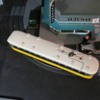Emboldened by the note in the Williams catalog that said it will "negotiate" D-21 curves, I ordered a Williams Peter Witt streetcar to run through my downtown 'Streets. I thought it would look nice, and it does. The good news is it runs just as well on DC as AC - I tried it on both and it makes no difference. Nice.
The bad news is: it's a pretty lousy negotiator. Here is is at 12 volts (DC) - and running quite a bit faster than I ideally want, negotiating some short (1 section, max) D-21 curves. It really slows down in them, almost stalling. Although it will run an slower speeds, it stalls in both places shown in the video at lower voltages lower than 12 V (DC or AC - I tried both).
Edit: and no, it is really not hitting anything else when it "hits" a curve and bounces or bobbles a bit. That's how it reacts. This weekend I will see if I can teach it to negotiate better, somehow.








